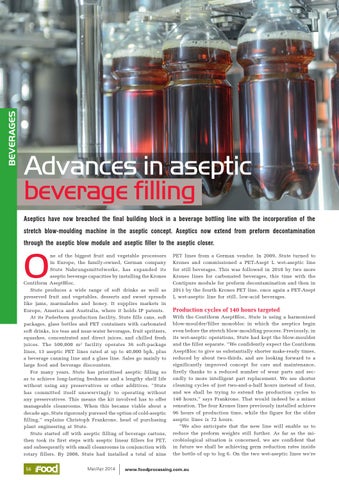BEVERAGES
Advances in aseptic beverage filling Aseptics have now breached the final building block in a beverage bottling line with the incorporation of the stretch blow-moulding machine in the aseptic concept. Aseptics now extend from preform decontamination through the aseptic blow module and aseptic filler to the aseptic closer.
O
ne of the biggest fruit and vegetable processors in Europe, the family-owned, German company Stute Nahrungsmittelwerke, has expanded its aseptic beverage capacities by installing the Krones Contiform AseptBloc. Stute produces a wide range of soft drinks as well as preserved fruit and vegetables, desserts and sweet spreads like jams, marmalades and honey. It supplies markets in Europe, America and Australia, where it holds IP patents. At its Paderborn production facility, Stute fills cans, soft packages, glass bottles and PET containers with carbonated soft drinks, ice teas and near-water beverages, fruit spritzers, squashes, concentrated and direct juices, and chilled fresh juices. The 500,000 m 2 facility operates 36 soft-package lines, 13 aseptic PET lines rated at up to 40,000 bph, plus a beverage canning line and a glass line. Sales go mainly to large food and beverage discounters. For many years, Stute has prioritised aseptic filling so as to achieve long-lasting freshness and a lengthy shelf life without using any preservatives or other additives. “Stute has committed itself unswervingly to operating without any preservatives. This means the kit involved has to offer manageable cleanrooms. When this became viable about a decade ago, Stute rigorously pursued the option of cold-aseptic filling,” explains Christoph Frankrone, head of purchasing plant engineering at Stute. Stute started off with aseptic filling of beverage cartons, then took its first steps with aseptic linear fillers for PET, and subsequently with small cleanrooms in conjunction with rotary fillers. By 2008, Stute had installed a total of nine 56
Mar/Apr 2014
PET lines from a German vendor. In 2009, Stute turned to Krones and commissioned a PET-Asept L wet-aseptic line for still beverages. This was followed in 2010 by two more Krones lines for carbonated beverages, this time with the Contipure module for preform decontamination and then in 2011 by the fourth Krones PET line, once again a PET-Asept L wet-aseptic line for still, low-acid beverages.
Production cycles of 140 hours targeted With the Contiform AseptBloc, Stute is using a harmonised blow-moulder/filler monobloc in which the aseptics begin even before the stretch blow-moulding process. Previously, in its wet-aseptic operations, Stute had kept the blow-moulder and the filler separate. “We confidently expect the Contiform AseptBloc to give us substantially shorter make-ready times, reduced by about two-thirds, and are looking forward to a significantly improved concept for care and maintenance, firstly thanks to a reduced number of wear parts and secondly to more intelligent part replacement. We see shorter cleaning cycles of just two-and-a-half hours instead of four, and we shall be trying to extend the production cycles to 140 hours,” says Frankrone. That would indeed be a minor sensation. The four Krones lines previously installed achieve 96 hours of production time, while the figure for the older aseptic lines is 72 hours. “We also anticipate that the new line will enable us to reduce the preform weights still further. As far as the microbiological situation is concerned, we are confident that in future we shall be achieving germ reduction rates inside the bottle of up to log 6. On the two wet-aseptic lines we’re
www.foodprocessing.com.au
